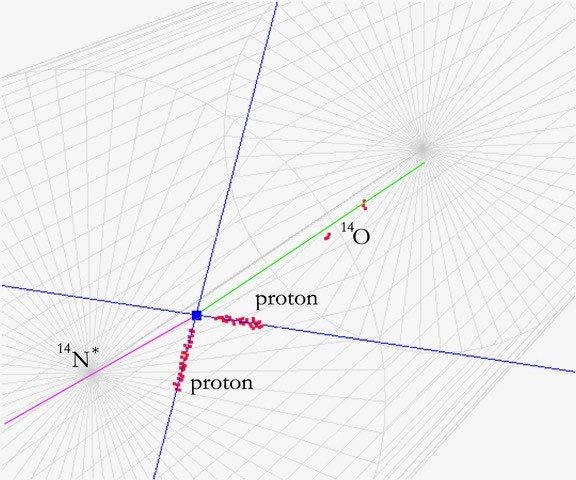A paper published in the journal Physical Review Letters describes a new technique to determine and study the nuclear reactions that take place in stellar explosions, such as supernovae. The researcher Yassid Ayyad, from the Instituto Galego de Física de Altas Enerxías (IGFAE), a joint centre of the University of Santiago de Compostela and the Xunta de Galicia, has participated in the work and has overseen developing part of the analysis and the framework of simulations necessary to interpret the results. According to the team in charge of the work, these data open a new avenue to tackle a series of scientific challenges, including astrophysics and neutrino physics.
As the authors explain, studying the nuclear reactions that occur in supernovae is essential for understanding the evolution of the universe. There is one type of supernovae (known as core-collapse supernovae), which affect stars larger than eight solar masses at the end of their life cycle. In this process, these giant stars generate a black hole or a very dense neutron star.
During this collapse, the atomic nuclei of the elements present in the core of the star capture electrons. These reactions reduce the pressure of the star and generate neutrinos that carry away energy. Modelling and better understanding these reactions therefore helps to unravel the unknown aspects of such large-scale phenomena.
Charge exchange reactions
Teams studying the reactions that generate this electron capture can indirectly obtain information on the rates of electron capture. They do this by means of so-called charge-exchange reactions, which can be carried out in a controlled manner in a laboratory. In these reactions, the initial nucleus and the final product are the same as those observed in stellar reactions. Therefore, if information is obtained on the probability of such a reaction occurring, it is possible to calculate the rate of the electron capture reaction that happens in a supernova.
However, until now, there has been a difficult hurdle to overcome in this indirect observation: only isotopes that are stable under conditions on planet Earth can be studied, and many of the isotopes that are generated in collapsing stars only live for a small fraction of a second when they are produced in the laboratory.
The relevance of the new work involving the IGFAE lies in the fact that the now-published paper has developed a new tool to overcome this obstacle, in an experiment performed at the US National Superconducting Cyclotron Laboratory (NSCL) at Michigan State University.
To do this, an unstable oxygen-14 beam was injected into an Active Target Temporary Projection Chamber (AT-TPC) filled with deuterium gas. From this, events were identified in which nitrogen-14 was produced, the same product that would appear after an electron-capture reaction in oxygen-14. In this reaction, a deuterium nucleus in the gas, consisting of a proton and a neutron, is converted into two protons.
“This is the first time that we have been able to measure this reaction in a radioactive isotope with sufficient resolution,” Yassid Ayyad, Ramón y Cajal researcher at the USC, explains. “To do so, we use the AT-TPC, a gaseous detector capable of measuring very low-energy protons. To carry out the experiment successfully, the IGFAE group has developed advanced simulation and analysis tools,” he adds.
The AT-TPC device allows a ‘picture’ to be taken of the tracks of the two protons obtained. This is sufficient to extract the necessary information that determines the electron capture reactions.
Furthermore, the oxygen-14 provided good results to understand the differences between the consolidated theoretical calculations, which require a correction factor to fit the experimental data. These data were obtained with more recently developed theoretical models, based on fundamental principles, which do not require a correction factor. The result is therefore not only important for astrophysical applications, but also for a better understanding of the fundamental properties of atomic nuclei.
Thus, the now published experiment paves the way for future tests with heavier and less stable nuclei that may be produced at the facility where this work is carried out.
Currently, the team led by Yassid Ayyad at the IGFAE is preparing a new work related to this technique. “We are working on a similar experiment to be done in July this year, using the same experimental device, but this time we will measure the electromagnetic response of 11Li, a very exotic nucleus characterised by two neutrons orbiting far away from the nucleus. This is what is known as a halo nucleus,” adds Ayyad. “This proposal is led by our research group and will serve as a thesis topic for one of our students,” he concludes.

The figure shows a visualisation of an event in the AT-TPC Chamber. An incoming oxygen-14 (top right) reacts with a deuterium nucleus, creating nitrogen-14 and two protons. The proton trajectories are reconstructed in the camera.
(Note: The other trajectories are hand-drawn for illustrative purposes only. They are not actually observed in the chamber).
The products of the nitrogen-14 reaction leave the chamber and are detected in the S800 magnetic spectrometer.
Credit: Remco Zegers (FRIB)
